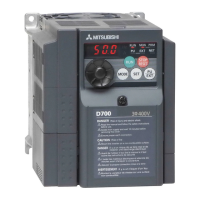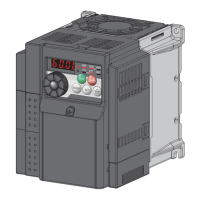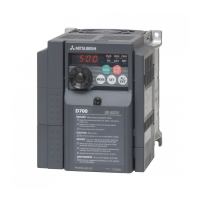What to do if Mitsubishi Electric FR-D720S-2.2K Inverter shows PU disconnection?
- SstephenevansSep 6, 2025
This function stops the inverter output if communication between the inverter and PU is suspended. Connect the parameter unit cable securely.

What to do if Mitsubishi Electric FR-D720S-2.2K Inverter shows PU disconnection?
This function stops the inverter output if communication between the inverter and PU is suspended. Connect the parameter unit cable securely.
What to do if Mitsubishi Electric FR-D720S-2.2K has overcurrent trip during acceleration?
If the inverter output current reaches or exceeds approximately 200% of the rated current during acceleration, the protective circuit activates and shuts off the inverter output. You can increase the acceleration time. If "E.OC1" is always lit at starting, disconnect the motor and start the inverter. Check for output short-circuit/ground fault and set 50Hz in Pr. 3 Base frequency.
What causes Mitsubishi Electric FR-D720S-2.2K overload trip and how to fix it?
The inverter output stops if the temperature of the output transistor element exceeds the protection level when a current not less than the inverter rated current flows and overcurrent trip does not occur (200% or less). To resolve this, increase the acceleration/deceleration time.
What does output current detection value exceeded mean on Mitsubishi Electric FR-D720S-2.2K?
This function is activated when the output current exceeds the Pr. 150 Output current detection level setting. Check the settings of Pr. 150 Output current detection level.
What to do if my Mitsubishi Electric FR-D720S-2.2K Inverter is showing overcurrent trip during constant speed?
If your Mitsubishi Electric Inverter is showing an overcurrent trip during constant speed operation, make sure the load is stable. Also, check the wiring for any output short circuits or ground faults. Try lowering the stall prevention operation level and activating both the stall prevention operation and the fast-response current limit operation (Pr.156).
How to resolve analog input fault on Mitsubishi Electric FR-D720S-2.2K Inverter?
An analog input fault appears if voltage(current) is input to terminal 4 when the setting in Pr.267 Terminal 4 input selection and the setting of voltage/current input switch are different. Give a frequency command by current input or set Pr. 267 Terminal 4 input selection, and voltage/current input switch to voltage input.
What happens when Mitsubishi Electric FR-D720S-2.2K has output phase loss?
If one of the three phases (U, V, W) on the inverter's output side (load side) is lost during inverter operation, the inverter stops the output. Ensure that the cables are wired properly.
What to do if my Mitsubishi Electric FR-D720S-2.2K Inverter shows overcurrent trip during deceleration or stop?
If your Mitsubishi Electric Inverter shows an overcurrent trip during deceleration or at a stop, try these steps: Increase the deceleration time. Check the wiring, looking for output short circuits or ground faults. Verify that the mechanical brake isn't activating too early. Also, consider lowering the stall prevention operation level and activating the stall prevention operation and the fast-response current limit operation (Pr.156).
What causes regenerative overvoltage trip during constant speed on Mitsubishi Electric FR-D720S-2.2K Inverter?
If regenerative energy causes the inverter's internal main circuit DC voltage to reach or exceed the specified value, the protective circuit is activated to stop the inverter output. Ensure that you keep load stable.
What causes motor overload trip on Mitsubishi Electric FR-D720S-2.2K Inverter?
The electronic thermal relay function in the inverter detects motor overheat due to overload or reduced cooling capability during low-speed operation. To resolve this, reduce the load weight.
| Series | FR-D700 |
|---|---|
| Model | FR-D720S-2.2K |
| Output Power | 2.2 kW |
| Horsepower | 3 HP |
| Output Current | 11 A |
| Output Frequency | 0.5-400 Hz |
| Communication | RS-485 |
| Weight | 2.5 kg |
| Overload Capacity | 150% for 60 seconds |
| Cooling Method | Fan cooled |
| Input Voltage | 200-240 V |
| Output Voltage | 3-phase 200-240V AC |
| Rated Output Current | 11 A |
| Frequency Range | 0-400 Hz |
| Control Method | V/f control |
| Braking Unit | Built-in |
| Protection | Overload, Overvoltage, Undervoltage |
| Protection Features | Overcurrent, Overheat, Short circuit |
Lists essential checks and handling methods to prevent product damage or shortened lifespan.
Explains how to implement interlocks using inverter status output signals for accident prevention.
Provides a comprehensive list of all parameters, their settings, initial values, and refer pages.
Covers PID control, dancer control, and regeneration avoidance functions for advanced operations.
Provides guidance on identifying and resolving common inverter faults, alarms, and operational issues.
Explains how to select and protect the motor, including overheat protection and auto tuning.
Explains automatic restart and power-failure deceleration stop functions for maintaining operation.
Covers functions like reset selection, parameter write disable, and password protection.
Describes procedures for resetting inverter faults and alarms, including auto reset.
Details functions like retry operation, phase loss protection, and earth fault detection.
Details how to select operation modes (PU, External, Network) and control sources.
Provides a comprehensive list of fault and alarm codes displayed on the operation panel with corresponding refer pages.
Explains how to assign functions to input and output terminals for various control operations.
Explains PU connector wiring, RS-485 communication, and Modbus-RTU specifications.
Details common causes for errors, warnings, alarms, and faults with corresponding corrective actions.












